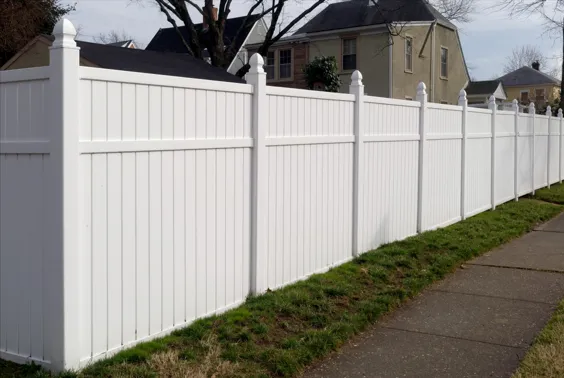5 Tips for an Easy Vinyl Fence Installation
At Texas Fence, we know vinyl fence installation adds curb appeal, boosts security, and offers low-maintenance durability. We plan, we prepare, and we execute when it comes to vinyl fence installation. For homeowners looking to improve their property’s look and function, installing a vinyl fence can be a rewarding DIY project. However, it doesn’t come without its challenges. From picking the right materials to getting the post-setting process just right, there’s a lot to think about. But don’t let that stop you. With the right tips and techniques, you’ll be well on your way to building a fence that looks great and lasts for years. Let’s walk through how to make this process smoother, safer, and more successful.

Key Points
- Choose a high-quality vinyl fence kit with all necessary components and gather appropriate tools before starting.
- Check local regulations, mark utility lines, and confirm property boundaries during pre-installation planning.
- Set posts correctly by digging holes 6-8 feet apart, ensuring they’re level, and securing with concrete.
- Install bottom rails first, then slide panels into place, using a level to ensure straightness along the fence line.
- Secure the top rail last, and add gates with proper hardware for a complete and functional vinyl fence installation.
Choosing the Right Vinyl Fence Kit
Selecting the appropriate vinyl fence kit is vital for a successful installation. We need to ponder our specific needs, whether we’re searching for privacy panels or decorative styles. It’s important to choose durable options, such as Freedom Outdoor Living vinyl fencing, to guarantee long-lasting performance for our outdoor space. Additionally, vinyl fences are recognized for their minimal maintenance, requiring only mild soap and water for cleaning, which further adds to their appeal.
When picking our vinyl fence kit, we must make sure it includes all necessary components. These typically consist of line posts, corner posts, end posts, and post caps. Having a complete set of materials will make our vinyl fence installation smoother and more efficient.
As we get ready for installation, let’s gather the appropriate tools. A post hole digger is essential for creating strong foundations for our fence posts. We’ll also need a sawzall for precise cuts, a level for accurate alignment, and a tape measure for proper spacing.
To ensure the success of our vinyl fence installation, we should follow some key tips. Let’s refrain from building against existing fences, verify proper post hole measurements, and use soapy water to facilitate rail installation. By sticking to these guidelines, we’ll create a beautiful and lasting fence for our outdoor living space.
Essential Tools and Materials
Let’s review the must-have equipment checklist for vinyl fence installation.
We’ll need stakes, ropes, a tape measure, level, post hole digger, concrete, and gravel as essential tools. Vinyl fences are known for their simple installation process, which makes them suitable for DIY enthusiasts.
Additionally, we should consider specialized tools like a power auger or fence post driver to streamline the installation process and guarantee precision.
Must-Have Equipment Checklist
Before starting on your vinyl fence installation project, it’s vital to gather all the necessary tools and materials. Let’s review our must-have equipment checklist to make sure we’re fully prepared for a smooth installation process.
First, we’ll need stakes and ropes to mark our fence line accurately. A tape measure and level are essential for maintaining proper alignment and height. For digging post holes, a post hole digger is necessary. We’ll also require concrete and gravel to secure the posts firmly in place.
Of course, don’t forget the vinyl fence panels themselves.
To maintain accuracy and stability throughout the installation, we must invest in quality tools. This investment will pay off in the long run, enhancing the durability and longevity of our fence. Having all these items on hand before we begin will save us time and prevent unnecessary delays.
Specialized Tools Overview
A handful of specialized tools and materials are essential for a successful vinyl fence installation. We’ll need stakes, ropes, and a tape measure for accurate layout, while a level ensures our fence posts are perfectly straight. A post hole digger is necessary for creating the foundation of our vinyl fencing project.
Let’s break down the key components we’ll need:
| Tools | Materials |
|---|---|
| Stakes and ropes | Vinyl fence panels |
| Tape measure | Vinyl fence posts |
| Level | Concrete |
| Post hole digger | Gravel |
| Concrete mixer | Vinyl gate kit |
We’ll use these tools and materials to create a durable and visually appealing fence. The stakes and ropes help us mark our fence line, while the tape measure ensures precise spacing between posts. Our level is important for keeping each fence post perfectly vertical, guaranteeing a professional look.
Don’t forget the importance of proper post installation. We’ll use our post hole digger to create deep, sturdy foundations for our vinyl fence posts. Adding gravel at the base of each hole improves drainage, while concrete provides the necessary stability. With these specialized tools and materials, we’re well-equipped to tackle our vinyl fence installation project efficiently and effectively.
Pre-Installation Planning and Preparation
Proper pre-installation planning and preparation are pivotal steps for a successful vinyl fence installation. Before we begin our vinyl fence installation project, we must check local zoning laws and HOA regulations to verify compliance with height and boundary restrictions. This step is essential to avoid costly violations and disputes later on. For instance, if you’re in Houston, you might look at Queenston Blvd. as a reference for local specifications.
Next, we’ll submit our plans for approval if required by local authorities. This precaution helps us steer clear of legal issues during the installation process.
We’ll also need to prepare our yard properly, which includes marking utility lines and property boundaries. This secures a safe and accurate installation.
Let’s confirm our property lines and mark the fence perimeter to prevent errors and ensure a successful installation. By taking these preparatory steps, we’re setting ourselves up for a smooth vinyl fence installation project.
Setting Posts Correctly
With our planning and preparation complete, we’re ready to begin setting posts – the backbone of our vinyl fence installation.
Let’s start by marking out our post locations, ensuring they’re spaced 6-8 feet apart for ideal support. We’ll use a post hole digger or gas-powered auger to create holes that are 1/3 the length of our posts deep.
As we set each post, we’ll focus on getting it perfectly level. This step is vital for maintaining a straight fence line and preventing future issues. A level handy will be our best friend here.
We’ll secure each post with concrete, making sure it’s plumb before moving on.
Remember, posts first, then panels. It’s crucial to allow the concrete to fully cure before attaching any fence sections.
While the concrete has set, we’ll double-check our post alignment and heights. This is our last chance to make adjustments before the installation becomes permanent.
Installing Rails and Panels
Let’s begin with attaching the bottom rail to the posts using screws or brackets, ensuring a stable foundation for the vinyl fence panels.
We’ll then slide the panels into the bottom rail, creating a seamless appearance along the fence line.
Bottom Rail Attachment
The bottom rail serves as the essential foundation for your vinyl fence installation. Let’s make sure we attach it correctly for a secure and professional-looking fence. We’ll start by aligning the bottom rail with the pre-cut slots on the fence panels. This alignment is pivotal for easy panel installation later.
Next, we’ll use a level to verify the bottom rail is straight and even along the entire fence length. This step is crucial for achieving that polished look we’re after. Once aligned and leveled, we’ll securely attach the rail to the vinyl fence posts using screws or brackets.
Here’s a quick reference guide for bottom rail attachment:
| Step | Action | Significance |
|---|---|---|
| 1 | Align with slots | Easy panel installation |
| 2 | Use level | Professional finish |
| 3 | Secure to posts | Stability |
| 4 | Set correct height | Flush panel fit |
| 5 | Check stability | Long-lasting fence |
Panel Insertion Technique
Now that we’ve secured the base rail, it’s time to focus on inserting the fence panels. The panel insertion method is essential for achieving a stable and visually appealing vinyl fence. We’ll walk you through the process to make sure you get it right.
Let’s begin by sliding the first panel into the base rail. This step is necessary for a secure fit and proper alignment. As we progress, we’ll attach the panels to the posts using screws or brackets, ensuring stability throughout the fence line.
Here’s a step-by-step guide to help you master the panel insertion technique:
- Install one panel at a time, sliding it into the base rail
- Use a level to verify each panel is straight and even
- Secure the panel to the posts using the appropriate hardware
- Repeat the process for each section along the fence line
Securing Top Rail
With the panels firmly in place, we’ll move on to attaching the top rail. This step is important for completing our vinyl fence installation and guaranteeing its stability and durability. Let’s work together to secure the top rail properly, as it plays a crucial role in maintaining the alignment and structure of our fence panels.
We’ll start by positioning the top rail along the upper edge of our vinyl fence panels. It’s necessary to ensure a snug fit before we begin fastening.
We’ll use screws or brackets to secure the rail, preventing it from popping out over time. As we work, let’s pay close attention to the alignment of the rail with each panel, making adjustments as needed.
Adding Gates and Hardware
Gates serve as important entry and exit points for your vinyl fence, requiring meticulous installation and proper hardware selection. Let’s focus on adding gates and hardware to guarantee smooth operation and security.
We’ll start by measuring and installing gate posts, ensuring proper alignment and stability. Next, we’ll securely attach hinges and gate hardware to the posts.
When working with a gate kit, remember to:
- Hang the gate on the hinges and adjust for correct swing direction
- Install a latch or lock for added security and access control
- Test the gate to ensure smooth opening and closing
- Make final adjustments before completing the installation
We’ll carefully attach the hinges to both the gate and posts, ensuring they’re level and properly aligned. The latch should be installed at a comfortable height for easy operation. Remember, precise installation of these components is vital for the gate’s longevity and functionality.
Maintenance and Care Tips
After installing your vinyl fence and gates, it’s important to understand proper maintenance and care procedures. We’ll guide you through essential tips to keep your fence looking great and lasting longer.
Let’s start with regular cleaning. We recommend using a garden hose to rinse off dirt and debris. For tougher stains or algae build-up, a mixture of bleach or vinegar with water works wonders. This simple step prevents mold growth and keeps our fence pristine.
We must also stay vigilant about repairs. If we notice any damaged sections, let’s address them promptly. Quick action guarantees our fence’s longevity and maintains its appearance.
Remember, we’re all in this together to keep our neighborhood looking its best.
While vinyl fences are known for their low maintenance, our collective effort in proper care enhances their durability. By following these maintenance tips, we’re not just preserving our fence’s aesthetic appeal; we’re also safeguarding our investment.
Let’s take pride in our vinyl fences. With minimal effort, we can enjoy their beauty and functionality for years to come. Together, we’ll maintain our fences and create a welcoming community atmosphere.
Frequently Asked Questions
What Do You Put Under a Gap for a Vinyl Fence?
We’ll place wood pieces under our vinyl fence to create a gap. Let’s use treated lumber or composite blocks for durability. We’ll guarantee they’re evenly spaced and level, providing consistent lift for proper drainage and maintenance access.
Is It Easy to Install a Vinyl Fence Yourself?
Can we install a vinyl fence ourselves? You bet! We’ll find it’s not as overwhelming as it seems. With proper planning, the right tools, and following instructions carefully, we’ll tackle this DIY project together and save money too.
How Deep Should Vinyl Fence Posts Be in the Ground?
We’ll want to bury our vinyl fence posts at least 2 feet deep for stability. In harsh weather areas, we should aim for 3 feet. Let’s follow manufacturer guidelines to guarantee our fence withstands wind loads and remains secure.
Should the Bottom of a Vinyl Fence Touch the Ground?
We recommend leaving a gap. No, vinyl fence bottoms shouldn’t touch the ground. We suggest maintaining a 2-3 inch clearance for drainage, airflow, and longevity. This prevents moisture damage, debris accumulation, and guarantees our fence stays beautiful for years.
Takeaway
We’ve covered the key steps for an easy vinyl fence installation. From selecting the appropriate kit to upkeeping your completed fence, each phase is important for a successful project. Remember, accuracy is vital. As we’ve seen, a well-installed vinyl fence isn’t just a boundary; it’s a proof of your skill and attention to detail. By following these tips, we’ll guarantee our fences stand tall and proud for years to come. Isn’t it time we enclosed our dreams?








